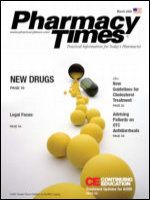Publication
Article
Pharmacy Times
Clarinex (Desloratadine)
Author(s):
IntroductionRemarkable progress has been made in the management of hypersensitivity reactions in the field of immunology over the past decade. Approximately 40 million Americans suffer anywhere from mild to severe forms of either immediate or late hypersensitivity reactions. In most patients, hypersensitivity reactions result from the activation and release of histamine from basophils and mast cells following an exposure to appropriate allergens. The most common symptoms of immediate hypersensitivity include rash, allergic rhinitis, asthma, and, in rare circumstances, life-threatening anaphylactoid reaction. In addition to the identification and avoidance of allergens, the use of antihistamine is advocated for relief of many of these common symptoms of hypersensitivity reactions. Deslorata-dine (Clarinex, Schering-Plough Corporation, NJ) is the active metabolite of loratadine and was recently approved for the relief of both nasal and non-nasal symptoms of seasonal allergic rhinitis in adult patients. (1,2)
Pharmacology
Similar to loratadine, desloratadine is a nonsedative antihistamine with (selective activity against histamine (H1) receptors. In nasal histamine animal models, desloratadine was more effective than terfenadine or loratadine in blocking histamine-mediated responses. Compared to conventional antihistamine drugs, desloratadine has minimal anticholinergic effects. Peak plasma concentration of desloradatine occurs within 3 hours following oral administration. The rate and extent of desloratadine absorption is unaffected by food. Desloratadine is extensively metabolized in the liver and has an active metabolite 3-hydroxydeslorata-dine, which is ultimately glucuronidat-ed. The plasma elimination half-life of desloratadine is 27 hours. (3,4)
Clinical StudiesResults from several clinical studies have shown that desloratadine is a specific H1 receptor antagonist with similar efficacy as the loratadine. According to four major studies, 1,838 patients were randomized to desloratadine (2.5 to 20 mg daily) or a placebo for 2 to 4 weeks. Doses of 5, 7.5, 10, and 20 mg were significantly superior to the placebo group in relief of seasonal allergy. No additional benefit was reported at doses above 5 mg daily. However, increased somnolence was reported in the 10- and 20-mg groups. In another study, the safety and efficacy of deslo-ratadine were compared to placebo in the treatment of chronic idiopathic urticaria. Patients randomized to deslo-ratadine 5 mg orally had significant improvement in reducing symptoms after 24 hours of treatment. In addition, the desloratadine group had better quality of life overall compared to the placebo group.(1,5)
Adverse Drug Reactions
Adverse reactions are similar to those observed with other nonsedative antihistamines and include pharyngitis, dry mouth, and fatigue. Unpublished studies suggest no significant effect on QT intervals following single and repeated administration at higher doses. Prolongation of QT intervals was reported previously with the use of both astemizole and terfenadine. Initial studies have indicated that deslorata-dine is not associated with a significant risk of ventricular arrhythmia. (5,6)
OutlookOral desloratadine has been an effective agent in reducing both nasal and nonnasal symptoms of seasonal allergic rhinitis. Desloratadine is also effective in other hypersensitivity reactions. However, desloratadine does not offer any major advantages over the generic formulation of loratadine. Further studies are needed to assess any potential for the use of desloratadine over other nonsedative antihistamines.
For a list of references, send a stamped, self-addressed envelope to: References Department, Attn. E. McCardell, Pharmacy Times, 241 Forsgate Drive, Jamesburg, NJ 08831; or send an e-mail request to: [email protected].







